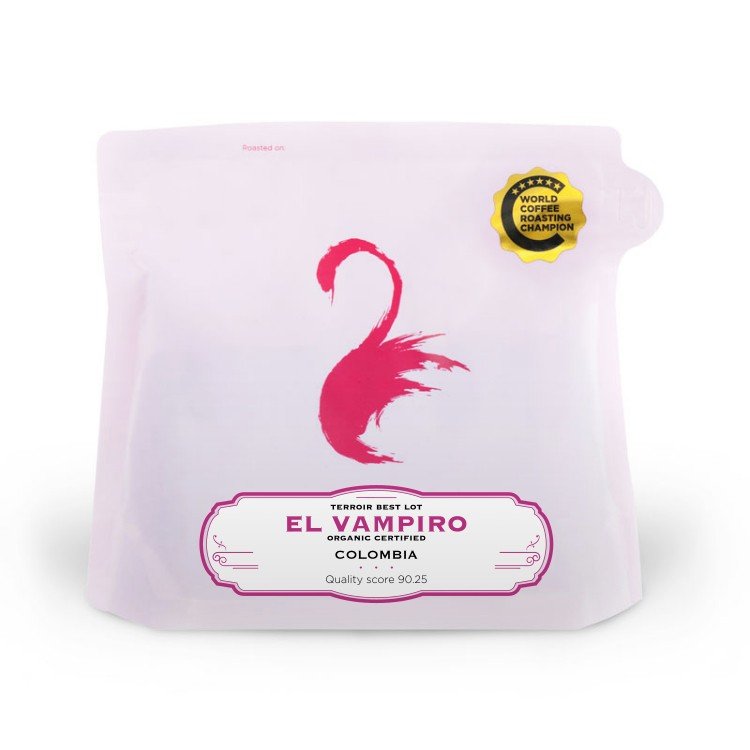






Colombia
250g
*Terroir Best Lot*
Cup Notes
Blackberry / Fig / Papaya / Prune / Clementine
Suggested for espresso and filter
QUALITY SCORE: 90.50
when we roast
We freshly roast to order all coffees on Monday, Wednesday and Friday (excluding national holidays), and ship the same day! Cut-off time is 11:59pm (UTC+1) of the day before the roast day. *We only ship whole beans*
This pure, organic coffee is the only one in Antioquia that is 100% certified organic. The coffee trees are raised on the pristine steep slopes of the Andes overlooking the Cauca River. Finca owner Luis Emilio Vélez allows the wild vampire bats on his finca to live inside his coffee storage. In the same space as the well protected coffee bags. He always stores all his coffee on the farm in GrainPro. You could almost say coffee grower Luis Emilio is a freak, but in the positive sense. He does not allow any compromise to produce his characteristic purely organic coffee. He recycles everything and promote his attitude everywhere he goes. For instance he collects al the plastic wrappers of friends and family, has them stuffed in plastic soda bottles and uses these as bricks to construct buildings on his farm!
Visiting Cocondo, near the small town of Titiribí in Antioquia, you’d be forgiven for thinking that the farm’s name is a play on words inspired by Macondo, the mystical town where Garcia Marquez´s famous novel, A Hundred Years of Solitude, takes place. Indeed, the setting is magical….and real! However, Luis Emilio Velez, the owner, will explain to you that the farm’s name derives from its location. Nothing more. Although the farm’s real name is Tebaida, many years ago villagers gave it the name Cocondo, an abbreviation of ‘coco hondo’, which literally translates as ‘deep coconut’. This strange moniker refers playfully to the farm’s location in the lower part of a steep ridge that looks not unlike a hollowed out coconut when viewed from above.
The plantation has been developed without harming any of the original vegetation. A walk through the coffee fields, feels more like a pleasant (though steep) forest stroll. Luis Emilio even created an eco-trail, complete with signs, that winds through various lots with different varieties, a spring and even a small fall that he sometimes uses as a shower.

In 1961, Colombia’s Coffee Research Institute, CENICAFE, began research and field trials with Hibrido de Timor. By 1968, the same organization was combining Timor hybrid with the popular Caturra cultivar, a program that was to continue in even fuller force throughout the 1970s. In 1982, CENICAFE released the Colombia cultivar, a product of five generations of breeding and backcrossing in the Catimor line in order to marry disease resistance with good cup quality and productivity.
Research continued throughout the 1980s and 90s and, even, accelerated in the race to discover a truly resistant strain that didn’t sacrifice flavour. In 2002, CENICAFE introduced the Tabi cultivar: a variety obtained by crossing Typica, Bourbon and Timor Hybrid. One of the most important attributes is its resistance to coffee leaf rust, but it also displays the good cup quality characteristics of its Bourbon and Typica parents.
Tabi is morphologically very similar to Bourbon and Typica, being tall with long branches; however, its fruits and seeds are slightly larger. It can be grown in high density (up to up to 3,000 trees per hectare) and adapts well to high altitudes.
The name Tabi means “good” in the Guambiano (a native Colombian tribe) dialect.

Dry process seems simple: pick the fruit, lay it out in the sun until it turns from red to brown to near-back, and then hull off off the thick, dried outer layer in one step to reveal the green bean. It is a method suited to arid regions, where the sun and heat can dry the seed inside the intact fruit skin.
It's often referred to as "natural coffee" because of its simplicity, and because the fruit remains intact and undisturbed, a bit like drying grapes into raisins. Since it requires minimal investment, the dry process method is a default to create cheap commodity-grade coffee in areas that have the right climate capable of drying the fruit and seed.
But it’s a fail in humid or wet regions. If the drying isn't progressing fast enough, the fruit degrades, rots or molds.
Dry-processed coffees can also be wildly inconsistent. If you want a cleanly-fruited, sweet, intense cup, dry process (DP) takes more hand labor than the wet process. Even the most careful pickers will take green unripe or semi-ripe coffee off the branch as they pick red, ripe cherry. If these are not removed in the first days of drying, the green turns to brown that is hard to distinguish from the ripe fruit.
